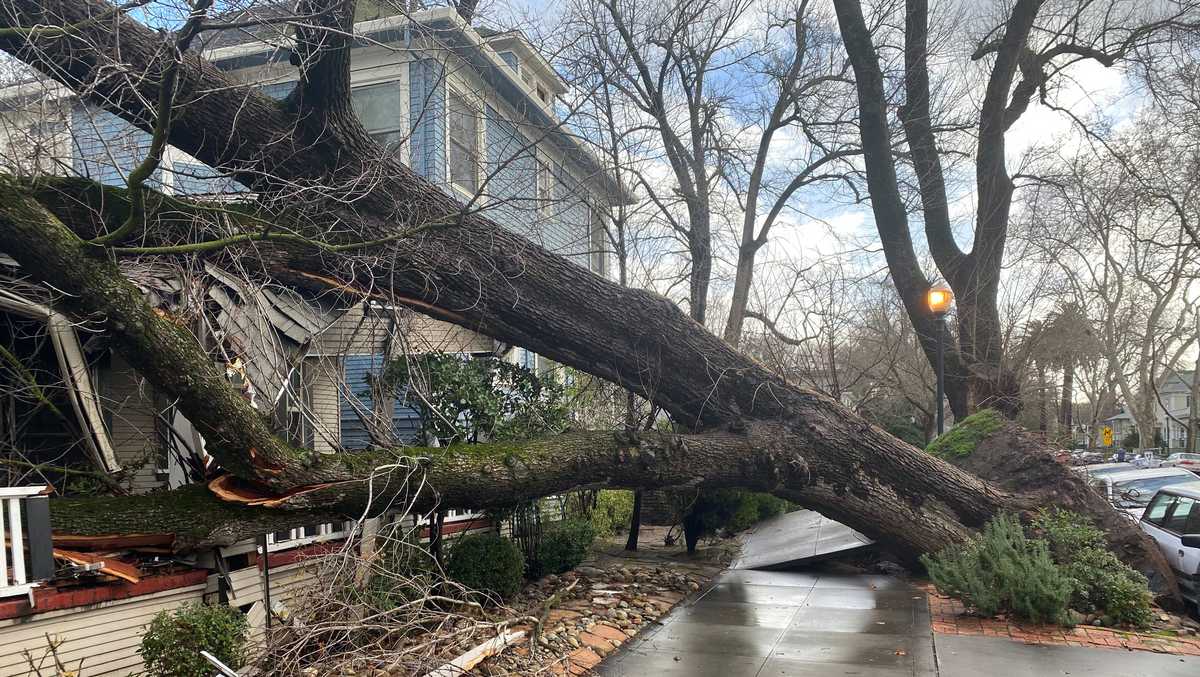Californians are coping with more rain, snow, floods and power outages

Californians dealt with floods and landslides as a series of powerful storms hit the state Monday, closing schools, uprooting trees and causing tens of thousands of power outages. Deputy County Administrator Melodye Serino said: The San Lorenzo River was declared at flood stage, and social media videos showed neighborhoods flooded with muddy water rushing up to a stop sign. In Northern California, several districts closed schools due to the storm. More than 35,000 customers remain without power in Sacramento, according to the Public Works District of the City of Sacramento. That’s down from more than 350,000 the day before after gusts of 60 mph smashed trees against power lines. ” — A storm that is a long plume of moisture that stretches into the Pacific Ocean and can bring down staggering amounts of rain and snow. Thousands lost power last week, flooded streets, and high waves shattered coastlines.President Joe Biden declared a state of emergency in California on Monday. Gov. Gavin Newsom said 12 people have died as a result of storms over the past 10 days, and this week’s storms could be even more dangerous. Twenty-three people have died and more than 100 homes have been destroyed in the coastal community of Montecito, as the first, more intense storm in recent days has sent the weather agency to the north. Flood watch has now been issued for much of California and Central California, with 12 inches of rain expected by Wednesday in the already saturated foothills of the Sacramento area, about 70 miles south of San Francisco. In the remote Aptos coastal area, crews unloaded sandbags ahead of high tide, which flooded last week, leaving piles of sand and debris in streets.In the Los Angeles area, storms hit late Monday and Tuesday. conditions were expected, with up to 8 inches of rain possible in the foothills. Nearly a foot of snow fell, and while the storm isn’t enough to formally end the ongoing drought in California, it has helped, state climatologist Michael Anderson said over the weekend. In a news briefing on Monday, officials said they are closely monitoring Monday’s storm and another behind it, and are monitoring three other systems further out in the Pacific.Daniel Swain, California A climate scientist at the University of Los Angeles said Californians can expect rain to stop after January 18,” he said.
Californians grappled with flooding and landslides Monday as the latest in a string of powerful storms hit the state, shutting schools, uprooting trees and powering out tens of thousands of people.
Santa Cruz County has issued an evacuation order for about 32,000 residents living near rapidly rising rivers and streams, said county deputy administrator Melodye Serino. The San Lorenzo River was declared at flood stage, and videos on social media showed neighborhoods flooded with muddy water rushing up to a stop sign. Mudslides in mountainous areas blocked roads and authorities urged residents to stay home.
In Northern California, several school districts closed schools because of the storm. In Sacramento, more than 35,000 customers are still without power, according to the city of Sacramento’s Utility District, where he was cut from more than 350,000 the day before after 60 mph gusts knocked over trees and pierced power lines. Decreased.
The US National Weather Service warned of a “constant parade of atmospheric rivers.” This is a storm that stretches a long plume of moisture into the Pacific Ocean and can bring a staggering amount of rain and snow. The rain and snow expected over the next few days have already hit California with storms that have cost thousands of power last week, flooded streets and lashed coastlines with high waves.
President Joe Biden on Monday declared a state of emergency in California to aid storm response and relief efforts in more than a dozen counties, including Sacramento, Santa Cruz and Los Angeles. Gavin Newsom said 12 people have died as a result of the past 10 days of storms, warning that storms this week could be even more dangerous and urging people to stay home.
The warning was issued on the fifth anniversary of a landslide that killed 23 people and destroyed more than 100 homes in coastal areas of Montecito after a powerful storm.
The first of the latest more intense storms has prompted the Bureau of Meteorology to issue flood watches for much of northern and central California, with 6 to 12 inches of rain expected by Wednesday in the foothills of the already saturated Sacramento area. was expected.
In Aptos, a coastal community about 110 kilometers south of San Francisco, the crew lowered sandbags before high tide. The area was flooded last week, leaving mounds of sand and debris in the streets.
Stormy conditions were expected in the Los Angeles area for the remainder of Monday and Tuesday, with up to eight inches of rain expected in the foothills.
More than 10 inches of rain have fallen in San Francisco since December 26, and Mammoth Mountain, a popular ski area in the Eastern Sierra, has had nearly 10 feet of snow, according to the National Weather Service.
The storms aren’t enough to formally end the ongoing drought in California, but they have helped. It said it was closely monitoring the storm and another behind it, as well as three other systems further out in the Pacific.
Daniel Swain, a climate scientist at the University of California, Los Angeles, said Californians can expect the rains to stop after January 18th.
“That’s my best guess right now. It’s a good thing because it gives the Northern California rivers, and now the Central California rivers, a chance to go down,” he said.
https://www.wlwt.com/article/california-more-rain-snow-flooding-outages/42435793 Californians are coping with more rain, snow, floods and power outages
